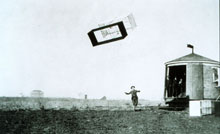Early Weather Observations
The Greeks were one of the first known civilizations to observe and document an interest in meteorology. Around 340 BC, Aristotle wrote the first weather book, Meteorologica. In the book, Aristotle identified such terms as clouds, rain, snow, wind, and hail. This text was the standard weather reference for the next 2,000 years.

Early on, kites were used to make weather observations. Click image for larger view.
From 1400 to 1600, several European scholars began to design and build weather instruments. In the early American colonial years, weather systems were observed and documented by several citizens. The importance of weather during military operations was clearly understood by the British Military and the American revolutionists conducting their campaigns. Citizens began to observe the movement of weather systems across the country and to link the weather in one city to the weather in a second city several days later. Forecasting and dissemination of this information was a huge challenge. The weather system arrived in a city sooner than the weather forecasts, as weather systems traveled faster than horses and their riders carrying the weather forecasts.
Today, weather observations and weather forecasts from around the country and the world can be obtained almost instantly thanks to modern information technologies, advances in weather observing instruments, and a greater scientific knowledge of the atmosphere and how it behaves.
